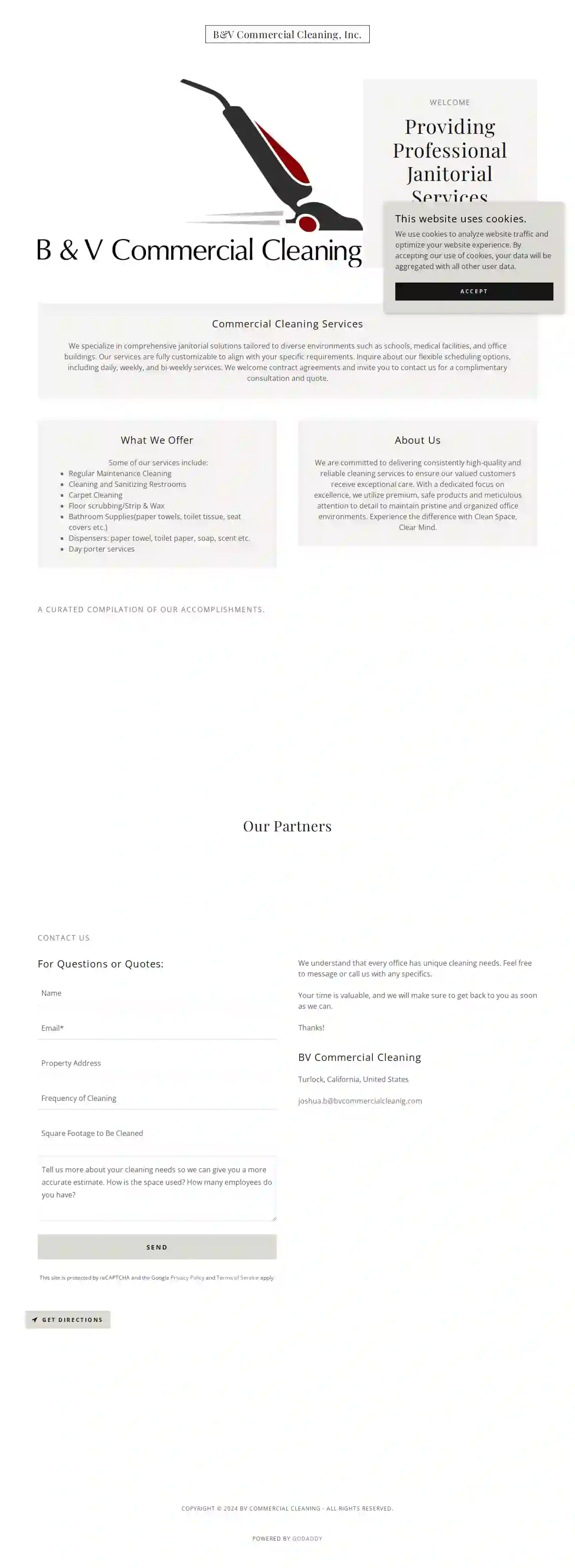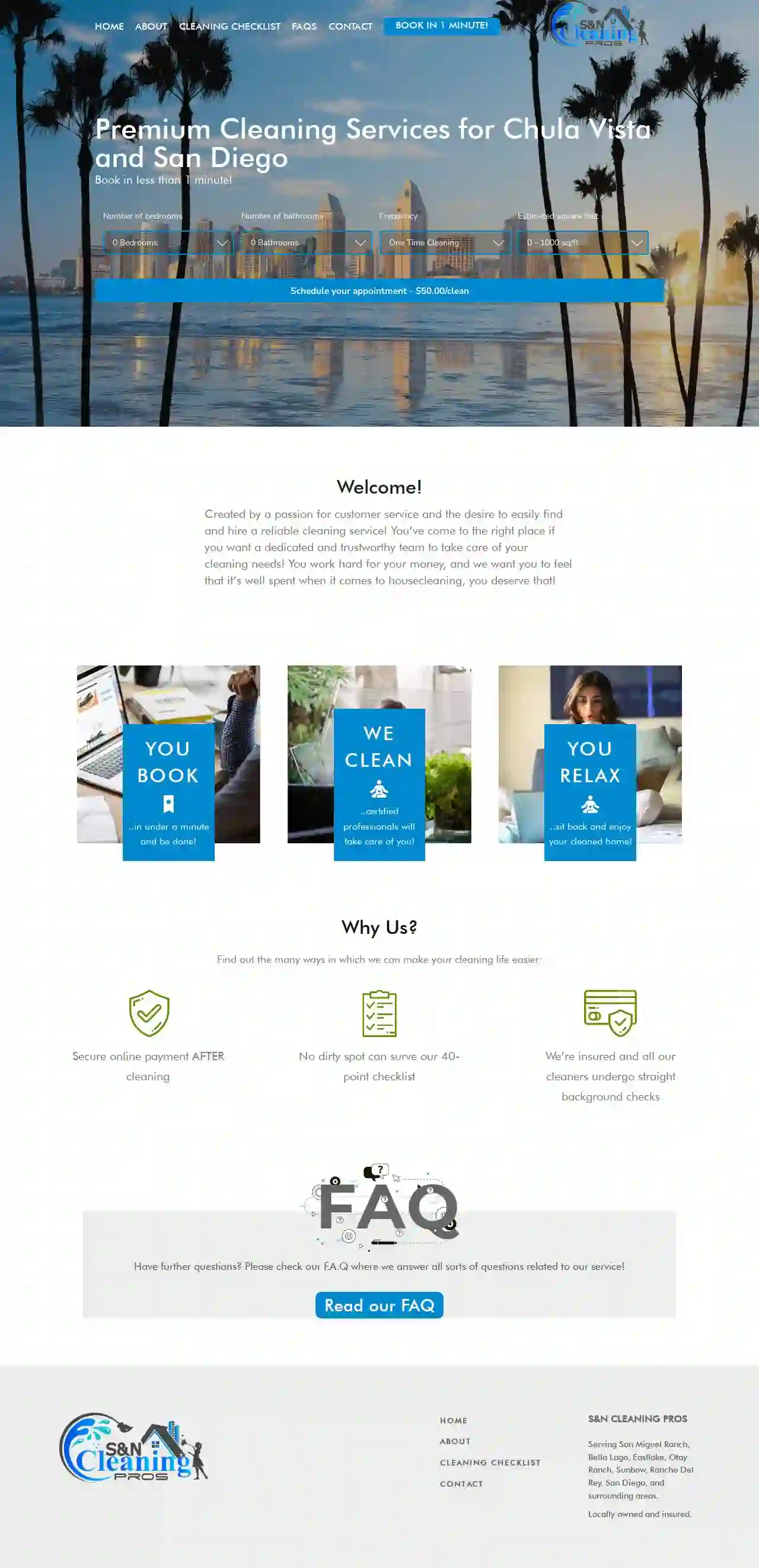Cleaning Services Lucas Valley-Marinwood
Find House Cleaning in Lucas Valley-Marinwood
Receive multiple Apartment Cleaning quotes for your project today! Compare profiles, reviews, accreditations, portfolio, etc... and choose the best deal.

B & V Commercial Cleaning, Inc.
59 reviewsTurlock, USAt B&V Commercial Cleaning, Inc., we specialize in providing professional janitorial services tailored to diverse environments such as schools, medical facilities, and office buildings. Our services are fully customizable to align with your specific requirements. With a dedicated focus on excellence, we utilize premium, safe products and meticulous attention to detail to maintain pristine and organized office environments. Experience the difference with Clean Space, Clear Mind.
- Services
- Why Us?
- Gallery
Get Quote
Clean & Bright Janitorial Service
54 reviewsSanta Barbara, US- Services
- Why Us?
Get Quote
S&N Cleaning Pros
521 reviewsVista, US- Services
- Why Us?
Get Quote
Congusto Services
5107 reviewsSan Diego, US- Services
- Why Us?
Get Quote
MVG All Pro Service
51 reviewsGlendale, US- Services
- Why Us?
Get Quote
Frontrange Move Out House Cleaning Services - Chula Vista
52 reviewsVista, US- Services
- Why Us?
Get Quote
Office Pride of Anaheim-Irvine
54 reviewsIrvine, US- Services
- Why Us?
Get Quote
Office Cleaning Solutions
511 reviewsSan Diego, US- Services
- Why Us?
Get Quote- NE
NEAT Janitorial Services
56 reviewsVisalia, US- Services
- Why Us?
Get Quote - Cl
Cleaning Services | The House Star Cleaning | House Cleaning Service
58 reviewsSunnyvale, US- Services
- Why Us?
Get Quote
Over 60,241+ Janitorial Services on our directory
Our janitorial contractors operate in Lucas Valley-Marinwood & surrounding areas!
CleaningMatch has curated and vetted the Best Janitorial Services arround Lucas Valley-Marinwood. Find a reliable contractor today.
Frequently Asked Questions About Cleaning Services
- Communicate clearly: Before the cleaning, communicate your expectations and any specific cleaning requirements. Provide a list of areas you want them to focus on or any tasks you want them to prioritize.
- Provide access: Ensure the cleaners have access to all the areas that need cleaning. Unlock doors, clear clutter, and provide any necessary instructions.
- Walk through after cleaning: Once the cleaning is complete, do a walk-through with the cleaners to inspect their work. Address any concerns or areas that need attention.
- Provide feedback: Give the cleaning service feedback on their performance. Let them know what you were happy with and any areas they can improve.
- Build a relationship: Establish a good relationship with the cleaning service by communicating openly, treating them with respect, and providing clear instructions.
- Cleaning: Removing dirt, dust, and debris from surfaces using soap or detergent and water. It improves the appearance and removes visible contaminants.
- Sanitizing: Reducing the number of bacteria on surfaces to a safe level. It uses chemical disinfectants or heat to kill or inactivate bacteria.
- Disinfecting: Killing or inactivating most disease-causing microorganisms on surfaces. It uses stronger chemical disinfectants than sanitizing and targets a wider range of pathogens.
- Ventilation: Open windows and turn on the exhaust fan to improve air circulation.
- Declutter: Remove any items from countertops, the shower, and the floor to allow easy access.
- Pre-treat: Spray shower walls, tub, and toilet bowl with bathroom cleaner and let it sit for a few minutes to break down grime.
- Toilet: Scrub the toilet bowl with a toilet brush, paying attention to the rim and under the seat. Wipe down the exterior of the toilet with a disinfectant wipe.
- Shower/Tub: Scrub the shower walls and tub with a sponge or scrub brush. Rinse thoroughly.
- Sink: Clean the sink with a sponge or cloth and bathroom cleaner. Pay attention to the faucet and drain.
- Mirrors and Glass: Wipe down mirrors and glass surfaces with a glass cleaner and a microfiber cloth for a streak-free finish.
- Floors: Sweep or vacuum the floor, then mop with a floor cleaner designed for your bathroom floor type.
- Finishing Touches: Empty the trash can, replace towels, and put away any toiletries.
Do I need to provide cleaning supplies for the cleaning service?
If you have specific preferences for cleaning products, such as eco-friendly or hypoallergenic options, communicate those to the cleaning service. They may accommodate your requests or allow you to provide your preferred supplies.
How can I make sure my cleaning service does a good job?
Clear communication, a thorough inspection, and constructive feedback are key to getting the best results from your cleaning service.
What is the difference between cleaning, sanitizing, and disinfecting?
Cleaning is usually the first step, followed by sanitizing or disinfecting depending on the level of hygiene required.
What is the best way to clean a bathroom?
By following these steps, you can maintain a clean and hygienic bathroom.
Do I need to provide cleaning supplies for the cleaning service?
If you have specific preferences for cleaning products, such as eco-friendly or hypoallergenic options, communicate those to the cleaning service. They may accommodate your requests or allow you to provide your preferred supplies.
How can I make sure my cleaning service does a good job?
- Communicate clearly: Before the cleaning, communicate your expectations and any specific cleaning requirements. Provide a list of areas you want them to focus on or any tasks you want them to prioritize.
- Provide access: Ensure the cleaners have access to all the areas that need cleaning. Unlock doors, clear clutter, and provide any necessary instructions.
- Walk through after cleaning: Once the cleaning is complete, do a walk-through with the cleaners to inspect their work. Address any concerns or areas that need attention.
- Provide feedback: Give the cleaning service feedback on their performance. Let them know what you were happy with and any areas they can improve.
- Build a relationship: Establish a good relationship with the cleaning service by communicating openly, treating them with respect, and providing clear instructions.
Clear communication, a thorough inspection, and constructive feedback are key to getting the best results from your cleaning service.
What is the difference between cleaning, sanitizing, and disinfecting?
- Cleaning: Removing dirt, dust, and debris from surfaces using soap or detergent and water. It improves the appearance and removes visible contaminants.
- Sanitizing: Reducing the number of bacteria on surfaces to a safe level. It uses chemical disinfectants or heat to kill or inactivate bacteria.
- Disinfecting: Killing or inactivating most disease-causing microorganisms on surfaces. It uses stronger chemical disinfectants than sanitizing and targets a wider range of pathogens.
Cleaning is usually the first step, followed by sanitizing or disinfecting depending on the level of hygiene required.
What is the best way to clean a bathroom?
- Ventilation: Open windows and turn on the exhaust fan to improve air circulation.
- Declutter: Remove any items from countertops, the shower, and the floor to allow easy access.
- Pre-treat: Spray shower walls, tub, and toilet bowl with bathroom cleaner and let it sit for a few minutes to break down grime.
- Toilet: Scrub the toilet bowl with a toilet brush, paying attention to the rim and under the seat. Wipe down the exterior of the toilet with a disinfectant wipe.
- Shower/Tub: Scrub the shower walls and tub with a sponge or scrub brush. Rinse thoroughly.
- Sink: Clean the sink with a sponge or cloth and bathroom cleaner. Pay attention to the faucet and drain.
- Mirrors and Glass: Wipe down mirrors and glass surfaces with a glass cleaner and a microfiber cloth for a streak-free finish.
- Floors: Sweep or vacuum the floor, then mop with a floor cleaner designed for your bathroom floor type.
- Finishing Touches: Empty the trash can, replace towels, and put away any toiletries.
By following these steps, you can maintain a clean and hygienic bathroom.